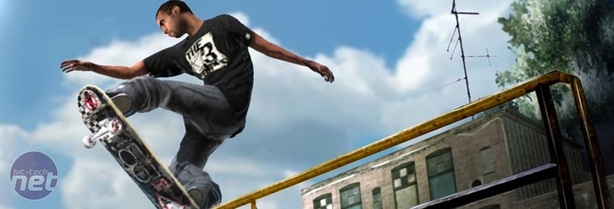
Stick it!
If there is just one thing that sets Skate apart from other skateboarding games, whether they be Tony Hawk's or not, then it’s got to be the controls.Simple to pick-up but tough to master, the controls for Skate are the backbone of the game and the secret of its success. If they had been any other way then Skate would have just been a Tony Hawk's clone, but as it stands it’s anything but that.
How it works is this, different parts of the controller are mapped to different parts of your skater's body. They aren’t just mapped to different moves or trick types; pressing A won’t make you do an ollie that’s identical to every other ollie, nor is Triangle the button which controls all the grinds. Instead, the left analogue stick is used to control your skater's body and the right analogue stick is used to control your board.
It sounds simple and kind of flawed, but the beauty of Skate is that there’s a serious, physical logic to it all.
If you want to do an ollie on your board for example then it’s not a case of just pressing the jump button, it’s a case of balancing your body with one stick and then hopping the board into the air like in real life – here manifested as a flick of the right stick. Then, since the right stick controls your board in totality, you can flick it to the sides or in different ways to do tricks like kickflips. By flicking down instead of up you can even do nollies instead of ollies.
The remainder of the buttons then control your limbs and it’s by using these in context to the environment and the rest of your actions that you build tricks. While your hands are controlled on the triggers, your feet are on the buttons and the fact that you can even choose which hand to use means that loads of different variations are opened up.
Context is everything though. Standing on your board and pressing the X button for example will have you hit the floor with your right foot and push-off, but if you pop an ollie into the air and do the same then you’ll slam that foot down again and spin a quick footplant – handy, provided you’ve remembered to grab your board with the triggers.
The benefit of this system is that the game starts to become a lot closer to the real-life skills used in the game. Winning is now no longer a matter of making sure you can dance your fingers fast enough to complete a combo; it’s a matter of timing and understanding how to use the board. You can even bust some new moves by thinking up clever ways to use these simple building blocks.
That, of course, is all old hat. If you’ve played the first Skate then you’ll know all that already. The big question then is; what’s new? Well, the first and most important change is quite simply put across – it’s the ability to get off your board and walk around on your feet, an act which should arguably change the name of the game from Skate to Stroll.
Naturally, the ability to get off the board is going to be hugely helpful for those moments when you’re trying to line up a perfect set of grinds and jumps, but it may also prove a bit controversial. I for one remember almost coming to blows with a friend when the ability to dismount the board was first introduced in Tony Hawk's. Sure, it may be helpful, but it’s also a great way to break the game by letting combos continue as you walk around.
Thankfully, Skate doesn’t handle walking in the same way as THUG and nor does it make it a matter of hammering the left and right foot buttons just to take a step. Instead, walking is introduced more as a tool than a trick thanks to the ability to interact with the environment in a direct and massively important way...

MSI MPG Velox 100R Chassis Review
October 14 2021 | 15:04











Want to comment? Please log in.